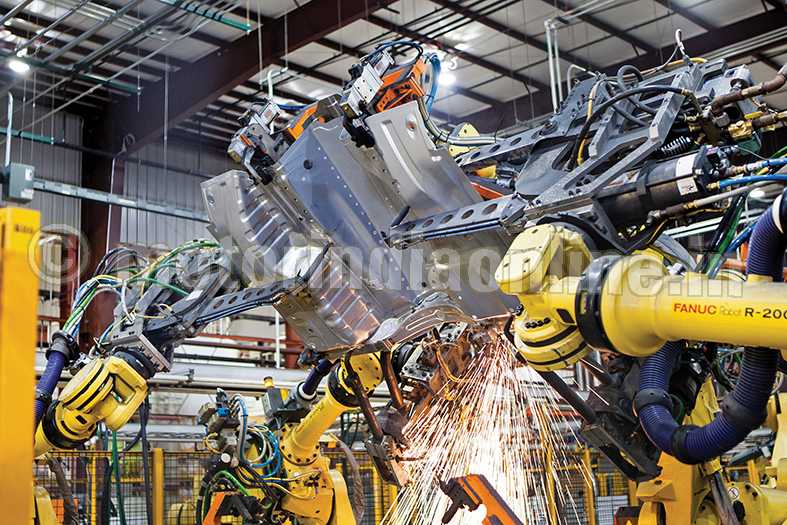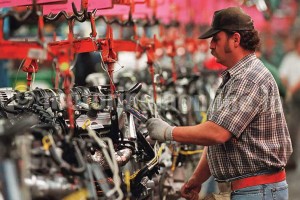MOTORINDIA’s exclusive interview with Mr. Brad Duguid, Minister of Economic Development, Employment and Infrastructure, Government of Ontario
Ontario in Canada is known the world over as a major global automotive power driving the overall growth of the province. Its huge automotive power is attributed to the growing foreign direct investment (FDI) made by overseas firms, particularly Honda which has been maintaining its close relations with the province by strengthening its vehicle plant set up in Alliston in 1986.
Mr. Brad Duguid, Minister of Economic Development, Employment and Infrastructure, Government of Ontario, explains in a detailed discussion with MOTORINDIA how the province’s automotive power has picked up so fast with its strategic approach to foreign investment, and also answers a series of questions related to its future growth policy.
Excerpts:
Q: How far will the Honda entry into Ontario benefit the auto component manufacturers in that region?
A: The auto sector is an important part of Ontario’s economy and contributes billions of dollars to the GDP while employing almost 100,000 people in the province. Honda has a rich history in the province of Ontario, establishing its first auto manufacturing plant in Alliston in 1986. Since then, Honda has produced over six million vehicles in Canada and the Honda Civic continues to be the best-selling passenger car in the country (a title it has retained consecutively for the past 16 years).
This recent investment further cements Honda’s strong relationship with the province and reinforces the province’s position as a global leader in auto manufacturing. It is expected to generate hundreds of millions of dollars in new business for the province and support the retention of 4,000 jobs at the plant, and thousands more across the supply chain, including among auto parts manufacturers in the region. Honda’s annual purchasing of components and services from suppliers in Ontario alone is in billions. With the new investment, Honda will continue to be a strong contributor to the economic well-being of Ontario’s automotive industry. The investment will also ensure the protection of thousands of well-paying, high-quality jobs in Alliston and throughout Honda’s supplier network in the province.
Q: Canada is a world leader in terms of its integrated approach to driving economic growth through innovation. Could you throw some light on Ontario’s contribution to the country’s growth through an innovative approach?
A: Ontario’s approach to driving economic growth involves nurturing a climate of innovation that includes a rich network of universities, private and public sector institutions and R&D centres in order to ensure that companies have the tools to develop breakthrough concepts and technologies and bring them to market. Ontario is also proud to partner with companies such as Honda that are making investments in leading-edge technologies that will reinforce their global competitiveness.
In addition to specialized centres such as the MaRS Discovery District, the Ontario Centres of Excellence and the province’s network of Regional Innovation Centres that offer commercialization and advisory support and R&D matchmaking, Ontario fosters innovation by providing companies with top-ranking R&D tax incentives and competitive business costs. Our dedication to innovation is reflected in the fact that almost half of Canada’s full-time R&D personnel are based in Ontario and more than $14.6 billion is spent annually on R&D.
The province also contributes to the country’s growth by attracting foreign direct investment and ensuring that we have a highly skilled workforce available to meet the demands of global powerhouses such as Honda. Companies such as Honda have taken notice, and Ontario is now the only province or state in North America to have five OEMs (Chrysler, Ford, GM, Honda and Toyota). The fact that the Alliston plant is the only Honda plant outside of Japan to be designated a “global lead plant” for production of the Honda Civic truly speaks of the knowledge and experience of its workforce.
Q: Since the automotive industry is generally regarded as an engine of growth both in developing and developed economies, I am sure the sector will be a major focus of attention of the Ontario Government as well. Your expert views, please.

A: Yes, Ontario’s automotive industry is an important driver of economic growth for the province and the country as a whole. Ontario is home to over 90 per cent of Canada’s automotive industry, and over 97,000 people in the province are directly employed in the auto manufacturing sector. The industry also supports hundreds of thousands of jobs throughout the province. The sector has demonstrated strength, with stable production and shipment values and strong provincial exports.
As a government, we are doing everything we can to ensure the industry’s continued success, and to actively promote its competitiveness on the world stage. Our support of up to 10 per cent for Honda’s $857 million investment in its Alliston facilities is a reflection of our commitment to growing the auto sector in Ontario and Canada. The investment will provide critical improvements in technology and manufacturing efficiency that will help ensure the sustainability of Honda’s operations in Ontario over the long term. It also reinforces Ontario’s standing as a global leader in auto manufacturing and, as Premier Wynne noted, “is a vote of confidence that we are a great place to do business.”
Q: Small and medium enterprises (SMEs) play a crucial role in the sustained growth of the automotive sector. How far is it true in your province?
A: Small and medium enterprises play a significant role in the sustained growth of Ontario’s automotive industry. In addition to increasing the quality and quantity of exports we have to offer the world, they are essential to attracting and retaining investment from global companies, such as Honda. They make up the economic eco-system that supports companies like Honda, and contribute positively to the automotive eco-system by providing deep sector expertise and competitive supply chain solutions.
Q: Canada and India have long-standing bilateral relations built upon shared traditions as ideal democracies. Could you please provide information on the current volume of bilateral trade and investments in the automotive sector?
A: In terms of investments, there are currently no Indian automotive companies that produce vehicles in Canada. However, some major Canadian automotive parts firms have a strong presence in India. For example, Linamar currently operates a manufacturing facility and sales centre in India. Likewise, Magna operates eight manufacturing facilities and five engineering/product design/sales centres in India, employing roughly 1,775 people.
From a trade perspective, the total of bilateral goods traded between Ontario and India amounted to $1.8 billion in 2013. Ontario is a net importer from India, with its exports ($373 million) valued at less than half of its imports ($1.4 billion). Passenger vehicle trade between Canada and India is currently limited, with only $120,000 in two-way trade in 2013. However, Ontario is continuing to ramp up production of a number of vehicles for the international export market, such as the Ford Edge and Honda Civic.
Canada and India are currently undertaking negotiations for a comprehensive free trade agreement. Negotiations were launched in November 2010, and an 8th round of negotiations was held June 24-25, 2013. Dates have not been set for the next round. An agreement could reduce tariffs on automotive goods and help eliminate non-tariff barriers to trade. It should be noted that provinces and territories are not directly participating in the negotiations.
Q: Last January, a lot of Canadian companies took part in the Auto Expo exhibition in New Delhi, looking at India as a strategic partner for the future. What about the current scenario?
A: India is amongst the priority markets for Ontario automotive parts manufacturing companies. Our companies continue to explore business opportunities in India. Some of these companies such as Litens Automotive Group, Valiant, Samco Machinery, Mould Masters, etc., now have manufacturing operations in India and a few of them are using their Indian facilities to service demands from other markets.
Q: Any special strategies adopted by the Ontario Government to woo investments from overseas auto companies?
A: The Ontario Government is dedicated to ensuring that the automotive industry in the province remains strong and highly competitive. Attracting foreign direct investment is a big part of our mandate, and Ontario continues to be one of the top performers in FDIs when compared with other states and provinces in North America.
We successfully attract investment from oversees because we actively foster a competitive business climate, promote entrepreneurship and innovation, and train the best and brightest workers. To ensure the competitiveness of the automotive sector, we offer one of the lowest business tax rates in North America, have excellent infrastructure, provide a well-trained manufacturing workforce, give generous tax credits, and have specialized manufacturing research and development activities.
The Ontario Government also recognizes the importance of partnering with the industry as it enters the next stage of development. We recognize that securing key investments will increase the sustainability of the sector. The Ontario Ministry of Economic Development, Employment and Infrastructure also recognizes the importance of the Federal Automotive Innovation Fund (AIF), a federal initiative to support strategic, large-scale research and development projects in the auto sector that will lead to greener, more fuel-efficient vehicles.
Q: Has your State any ‘single window clearance’ policy for the auto companies investing in Canada for the export market?
A: Ontario works closely with all levels of government, including the federal government, to ensure that automotive companies looking to invest in the province can start construction as quickly as possible and face minimal barriers to export once production begins.
Q: Today ‘Green Mobility’ has become a major initiative taken by each and every country. What about your province?
A: Ontario is committed to ensuring its auto sector plays a central role in the development of the next generation of vehicles by supporting the government’s research and innovation agenda through programs applicable to the research, development and commercialization of electric vehicles and their components parts. The government has partnered with a number of firms in order to position the province to take a leading role in vehicle electrification, including investments in Electrovaya and Dana to support battery technology, and investments to support Toyota in manufacturing the Lexus RX450h hybrid and the RAV4 EV in Ontario.
We have been active in encouraging consumer adoption of electric vehicles (EVs), including consumer incentive rebates on the purchase or lease of an electric vehicle, and a home charging incentive rebate on the purchase and installation of a private home charger. In addition to Ontario’s rebate programs, EV owners are provided with “green” license plates for EVs to drive in commuter (HOV) lanes with only one occupant.

